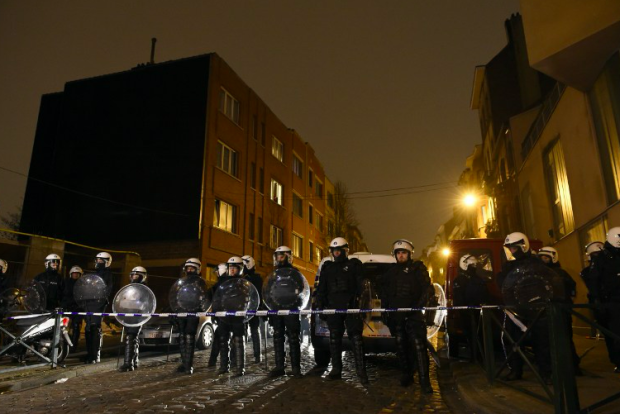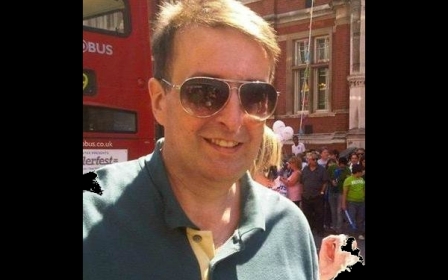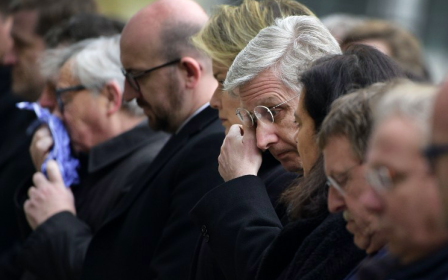Molenbeek: Belgiums' militant 'stronghold' or multi-cultural suburb?

BRUSSELS - In the aftermath of Tuesday’s deadly attacks, Brussels has become a city on edge. Residents have been flocking to the city’s central Place de la Bourse to show their solidarity with the 31 people who lost their lives and the more than 270 others who were injured. Some have left flowers, others have written messages of peace and love but divisions are also lurking and fears rising that citizens may start looking for scapegoats.
“I’m here to show that not all Muslims are the same,” said 11-year-old Dina, a Belgian citizen of Moroccan decent, who came to the square to light a candle to the dead.
She says that now more than ever it’s important for Belgians of all origins to stand together and show solidarity.
“I am very sad that this has happened. At first I couldn’t believe that this was happening. Not in my own country. Or in my own city,” she told Middle East Eye.
“Also, these terrorists are Muslims and now some people believe that all Moroccans support the terrorists, and that’s not true. I am against them as much as anybody else. And I’m here to show that we are stronger than the terrorists.”
The Islamic State group has claimed responsibility for Tuesday’s attacks that hit the city’s main airport at around 8am local time and then struck a busy metro station at rush hour. Two of the suspects were Belgium nationals while a third was a long-time resident.
Belgium is home to almost 700,000 Muslims who represent around 6.5 percent of the population. According to Belgian intelligence, at least 500 Belgian nationals have travelled to join the extremist group in Syria, proportionally more than any other country in Europe.
Yasmine’s son was one of those who left. Since Tuesday’s attack she says she is even more fearful and that she wants to hide from the world.
She says she is worried people will hold her responsible for what happened and that they are watching her even tough she has not heard from her son since he left.
“Each time an attack happens anywhere in the world, I’m afraid he might be involved,” she says while having a coffee in a cafe only a couple of metres away from the central square.
“People judge me for my son’s decision to leave for Syria,” she said. “But I don’t even know what he’s doing there. I don’t even know if he’s still alive. The only thing I can hope for is that he will never do something inhuman like this.”
Yasmine has lost friends since her son left and has also lost her self-confidence. Like most of the mothers of those who have choose to go to Syria and Iraq, Yasmine finds herself misunderstood and isolated.
“They are ashamed to be around me,” she said. “Often people believe that I’m a radical, and that I’m supportive of those committing these crimes, or believe that my other kids will have a bad influence on their children.”
The fight for Molenbeek
No more than ten minutes from the square rests the working class district of Molenbeek where many immigrants and Belgians of ethnic background live.
Molenbeek first shot to international fame last November after authorities established clear links between some residents and the Paris attacks that killed 130 people and staged a string of raids in the neighbourhood.
Earlier this month, Molenbeek was back in the news after police shot and seized another Paris suspect Salah Abdeslam after a prolonger gunfight. Days later, the deadly blast ripped through the capital.
Belgium’s Prime Minister Charles Michel responded by blaming the “perfect storm of failed or neglected integration, foreign fighters returning from Iraq and Syria, porous borders and intelligence and security apparatus struggling to keep pace with the scope and breadth of the threat.”
Since then the atmosphere in Molenbeek has been gloomy. The main shopping street - where shops usually proudly display their goods on the pavements - are almost empty. The shops haven’t closed their doors, but it feels like it.
“It’s a slap in our face,” Mahmoud Shenawi, a 32-year-old shopkeeper, said.
“Four months ago cameras from all over the world flooded in here,” he said. “For a while, a very short while, they seemed to have left. But now they are all back again. Saying that Molenbeek is the stronghold of European terrorists."
But for now, there is little hope that life will go back to normal. Authorities are on high alert with raids ongoing and authorities vowing to clean up the neighbourhood.
“When I tell people that I live in Molenbeek they ask me if I’m not afraid, or they don’t say anything and I realise that they are afraid themselves, of me, because I’m from Molenbeek,” said Nadya, a 43-year-old mother of two and long-time resident.
“What happened is horrible, we all condemn that. A handful of people have poisoned our hometown. Molenbeek is not a ghetto. It’s a good neighbourhood. And it shouldn’t be seen as a place of perdition, only because a group of people from here have chosen a very wrong path.”
The mayor of Molenbeek, Francoise Schepmans, has tried to fight back, pushing for solidarity and calling on the Prime Minister to visit the neighbourhood to experience its vibrancy and sense of community.
“We have the same values as in Australia, the United States, we want freedom and modernity and equality between women and men and we have to fight together for those values,” she said.
But for many the fear of stigmatisation remains.
"The only thing we want is to be left alone, because we also have a trauma to overcome,” Shenawi, the shopkeeper, said.
Middle East Eye propose une couverture et une analyse indépendantes et incomparables du Moyen-Orient, de l’Afrique du Nord et d’autres régions du monde. Pour en savoir plus sur la reprise de ce contenu et les frais qui s’appliquent, veuillez remplir ce formulaire [en anglais]. Pour en savoir plus sur MEE, cliquez ici [en anglais].





